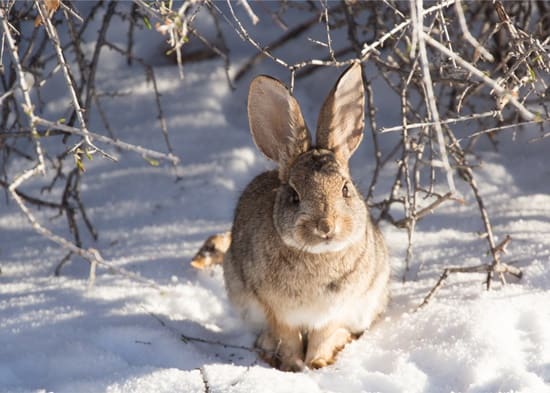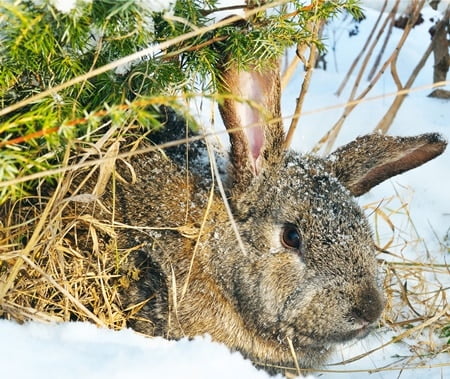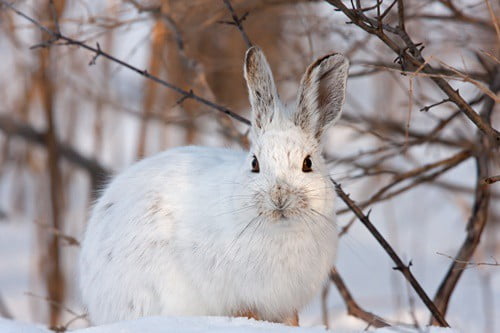Wild rabbits typically live within a 5-acre area. Their diets primarily consist of eating grass and other ground-level plants. However, after ice and snowfalls, they cannot access these food sources.
During the winter, rabbits take in more wood-based food sources, such as tree bark, twigs, and conifer needles. Rabbits don’t hibernate, so they dig holes or find warm, closed-in spaces, in hollow logs, rock piles, and brush piles.
But they don’t just eat plants. In addition to moths, snails, and other insects, they’re also known for eating their feces. Rabbit poop is an excellent source of Vitamin B that is produced by bacteria as the food passes through the large intestine.
Where Do Rabbits Go In The Winter?
Rabbits stay in their home territory and don’t move much. As long as a rabbit has enough food to build a layer of insulating fat in its body, it can survive in the cold. In the winter, rabbits also grow a thick coat of fur that helps keep them warm.
This shows that a wild rabbit’s chances of survival are largely dependent on its nutrition and the availability of food.
How Do Rabbits Adapt to Cold Weather?
| Winter Adaptation | How It Helps Rabbits to Survive |
|---|---|
| Switch to a coarser, wood-based diet | – Rabbits don’t hibernate and don’t travel far for food, so they need a readily available food source. This helps them to survive when food is scarce. |
| Increased ingestion of feces | – An excellent source of B vitamins – Allows for the complete digestion of food that has already been eaten – Provides nutrition when food is scarce |
| Continue to seek food sources | – To build a layer of fat in the body that will provide insulation and energy to produce heat. |
| Grow a thicker coat | – To keep warm |
| Create burrows or seek out hiding places | – To keep warm – To be safe from predators – To be near a food source |
| Reduced activity | – To conserve body heat. Rabbits regulate their body temperature through their ears – To survive when food is lacking – Fat stores are used more for maintaining an optimum internal temperature, and less for movement |
Where Do Rabbits Shelter in Cold Weather?
Food isn’t a wild rabbit’s only concern in the winter. Cold weather leads to loss of vegetation density, which means predators can spot wild rabbits more easily.
It’s not easy surviving amidst twigs and stems. Therefore, they must find shelter where they can hide from predators and eat without being harassed.
Wild rabbits seek winter quarters in thick bushes, solid fences, and evergreen trees. Hollowed out stumps and brush piles also offer cover in the winter.
Anything a predator cannot see a rabbit through works. Some rabbits also change their color so that they blend in the gray and white landscape of the winter.
Cover isn’t as attractive as food is for wild rabbits, however. Many rabbits also seek refuge in bushy areas close to agricultural fields. They scavenge for waste grains that are blown away by winds in fields clear of snow.
You may also notice wild rabbits in your yard during the winter months. If your home offers a place to hide and eat, it’s an ideal spot for a rabbit to seek shelter in.
In most homes, some rabbit-friendly food sources include leafy ornamental plants that remain visible after snow, tall shrubs and tree buds.
What Do Rabbits Eat In The Winter?
Wild rabbits are good at finding food, even during cold winters when their normal food sources are lacking. When there isn’t a steady supply of their desired grasses, clover, hay or berries, they will resort to two main sources of nutrients:
1) Wood-Based Sources
These include bush buds, twigs, and bark of rose and sumac bushes, as well as woody plants, such as birch, willow, and oak trees.
In the Midwest states, waste agricultural grains, including soybeans, corn, wheat, and sorghum are highly sought-after and pack a nutritious punch for wild rabbits in the winter.
2) Cecotropes (Partially Digested Feces)
Rabbits reingest up to 80% of their cecotropes (partially digested or night feces).
Consumption of poop is referred to as coprophagy. Rabbits have to eat their feces in the winter because of their inefficient digestive tracts.
According to The Cornell Veterinarian, bacterial synthesis occurs in the lower gastrointestinal tract, where there is little nutrient absorption. Ingesting their feces allows rabbits to obtain more nutrients, such as vitamin B, from the food they’ve already eaten.
This practice allows rabbits to make the most out of the food that is available to them, and survive the scarcity of food in the winter.

Do Rabbits Hibernate In The Winter?
Rabbits do not hibernate during wintertime. In fact, they can tolerate the winter better than warm weather. They continue to actively seek food sources throughout the winter months to keep warm and survive.
The reason you don’t see many wild rabbits in the winter is that they are most active during dusk or dawn. The weather is milder around these periods, and the darkness reduces their chances of being caught by a predator. During this time, wild rabbits will forage for food.
Rabbits spend much of their remaining time resting under vegetation or burrows. If you do notice wild rabbits outside your house or in your yard, it probably means they’ve found a good food source nearby. However, they do undergo diet and behavioral changes during colder days.
How Do Rabbits Survive Without Hibernating?
Hibernation involves sleeping for an entire season and setting your body into a dormant state. This means normal bodily processes, such as digestion, occur at a much slower rate.
Many animals hibernate in the winter because the harsh weather and scarcity of food can kill them. Luckily, for wild rabbits, this isn’t a problem because food is available to them throughout the year.
Although rabbits do not hibernate, they do get more sleep than humans. Rabbits sleep 8 hours a day. However, unlike humans, rabbits get their 8 hours of sleep by napping for short periods (about 25 minutes) several times throughout the day.
How Do Wild Rabbits Keep Warm In The Winter?
Physical adaptations such as growing a thicker coat and building a layer of fat help wild rabbits keep warm in the winter.
Rabbits are vulnerable to cold drafts. Therefore, they will fill their nests with grass and straw, which trap their body heat and function as perfect insulators. This helps rabbits maintain their normal body temperature of around 102 to 103 degrees F, according to the Michigan State University.
According to The Journal of Wildlife Management, the eastern cottontail rabbit doesn’t dig its burrows. It will either look for an empty burrow from another animal or huddle under woody vegetation. In suburban regions, these rabbits will keep warm near garages or under porches or cars.
Rabbits also spend most of their day sitting still and staying in one place to conserve body heat.
Heat Production in Rabbits
Rabbits keep warm by primarily burning the fat in their brown adipose tissues. Fat in the body exists in the form of white and brown adipose tissue.
- White Adipose Tissue. Also called white fat, is the standard fat that stores energy in large fat droplets. These droplets accumulate around the body and insulate the organs.
- Brown Adipose Tissue Fat. Or brown fat takes less space to store the same amount of energy as white fat. It gets its color via iron-rich mitochondria. When brown fat burns, it creates heat. This is a process called thermogenesis.
In the Journal of Physiology, the rates of oxygen consumption were studied in young rabbits at 34 and 15 degrees Celsius following varying periods of cold exposure and starvation.
- The rabbits kept at 20 degrees Celsius lost 83% of their stored fat in their brown adipose tissue within 24 hours and another 11% in another 24 hours. Their white adipose tissue fat had fallen by 75% after 48 hours.
- The rabbits kept at 34 degrees Celsius lost 47% of their brown adipose tissue fat and 44% of white adipose tissue fat after 48 hours.
A final cold exposure resulted in higher serum fatty acids and glycerol concentrations in rabbits kept at 34 degrees Celsius. Much lower concentrations were observed in rabbits kept at 20 degrees Celsius.
Results showed that rabbits preferentially burnt fat from their brown adipose tissue for heat production. As the fat reserves get exhausted, a rabbit’s brown adipose tissue continues to produce heat by oxidizing glucose and fat from food.

How Cold Can Rabbits Tolerate?
Rabbits are cold-weather animals by nature. Certain adaptations allow rabbits to tolerate cold temperatures that are even lower than 32 degrees Fahrenheit.
However, they are vulnerable to pneumonia, especially if they’re exposed to wet or damp conditions.
Furthermore, older rabbits prone to arthritis may have a tougher time during cold and damp conditions. Arthritis is not only a painful condition, but it can also cause severe complications, such as sore hocks and fly strikes due to a rabbit’s reluctance to groom.
Rabbits are in danger of developing hypothermia once their temperature drops below 100 degrees F rectal temperature. Hypothermia is the point at which the natural ability to regain normal body temperature is lost.
Hypothermia In Rabbits
A rabbit with hypothermia will no longer be able to produce sufficient internal heat to replace the heat that is being lost to the environment. Normal functions, such as breathing and heart rate, slow down.
The severity of hypothermia in rabbits is broken down into three levels according to rectal body temperature:
- Mild: 86 to 89 degrees Fahrenheit
- Moderate: 71 to 77 degrees Fahrenheit
- Severe: 32 to 47 degrees Fahrenheit
Heat production is further compromised as the core temperature keeps dropping until their metabolic activity has slowed down to undetectable levels.
The rabbit can only survive if external heat is applied until core temperature returns to normal. In extreme cases, the ears and other external appendages may cool down to the point where severe, irreparable tissue damage occurs.


I fell in love with a wild cottontail rabbit in late November,She would come every day,soon as dark set in.She would sit and eat the hay and pellets,and veggies I would bring her.We had become friends in three weeks. Christmas eve day,she was in my yard ,waiting for me,and did a binky when she saw me She stayed ,even after she ate.She sat and stared at me ,I talked to her a good two hours. I
knew something was up,when she got up to leave,when she turned around two times and looked at me And she hasn’t came back.
My heart is hurting.Is there a chance she will come back when winter is over?I truly have fallen in love with her,I call her honey bunny,and she responded to it.
She just happened to come along
a couple weeks after my guinea
pig poohcha had passed away.I don’t think it was a coincidence,I
think it was a good thing.But now
I’m scared for honey,being it’s winter and all?I there a chance she will come back when spring comes? I hope and pray, she does.
I had the same thing happen. Mine came back this week. Keep putting little bits of her food in a safe place. She will come back. They don’t go far from where they are born.
Yha that happened to me, mine didn’t come back, but I gave up and stopped looking. Perhaps she will but per chance she doesn’t at least you know it was a decision she knew she had to make, and she did say good buy, so as dr., seus would say “don’t be sad it’s over, be happy it happened”💕
Did Honey come home. I have two rabbits living under the deck (which is very low to the ground) so the shelter is good. I’ve tried pellets, but they are not eating them. I’m guessing there is still a good food source seeing that we are not covered in snow…….
We have a rabbit living under our deck also. I feed it an apple every couple of days and I uncover the snow in our yard so that it can access the grass more easily. In the past I have tried leafy vegetables and rabbit pellets for the wild rabbits but they seem to only be interested in the apples.
Dear Lou Carter,
Could you please share what species of rabbit is at the top of your post? I photographed a wild rabbit in winter that looked the same, but can’t identify it. I’m in NH.
Thank you!
-Suzanne H
Never mind – I found it – Snowshoe Hare!
You are correct.
Rescue to Bunny March 16, 2020, when I discovered its nest and it didn’t seem like the most coming home. Of the three bunnies one survived. It stuck pretty close by Costco and then late fall almost winter, in November, and left. Never thought I’d see it again until it showed up the next spring. Stayed with me the entire summer coming again that late next fall and aft again. Last year and Easterday of 2022, it showed up again. It’s about the entire summer with me here, and then the party weekend in November now in March 2023. I’m waiting for it to show up again.